What is Elon Musk’s Starship space vehicle?
- Science
- October 11, 2024
- No Comment
- 375
 Getty Images
Getty ImagesElon Musk wants his new rocket to revolutionise spaceflight. And that rocket, Starship, is now the largest and most powerful spacecraft ever built.
It’s also designed to be fully and rapidly reusable. His private company SpaceX, which is behind the creation, is hoping to develop a spaceship that can be used more like a plane than a traditional rocket system, being able to land, refuel and take off again a few hours after landing.
When will Starship’s next launch be?
While there’s no exact date set yet for the rocket’s next flight, it could be as soon as this weekend – and SpaceX is expecting big things.
This will be Starship’s fifth outing, and all eyes will be on the landing phases – specifically, the return of the vehicle’s bottom part, the Super Heavy booster.
So far we’ve only seen what might be called a simulated landing at sea, or ‘splashdown’. This will be the first time we hope to see the booster return to the launch pad.
For a spacecraft to be reusable, it needs to be able to land safely.
The SpaceX founder has said they will try to catch the booster in mid-air on its return to Earth using the giant mechanical arms, or ‘chopsticks’, of the launch tower – or as Musk calls it, “Mechazilla”.
That’s something that’s never been done before, and eventually SpaceX want to catch the Ship – the top part of the vehicle – in the same way. But that won’t happen on the upcoming test flight.
Will Starship go to Mars?
None of Starship’s missions so far have been crewed, and there’s no plans to put people aboard for the next flight either.
But Musk and his company do have grand designs that the rocket system will one day take humanity to Mars.
A Mars trip isn’t on the horizon just yet. But the behemoth rocket already has some impressive specs, and dwarfs all of its predecessors.
How big and powerful is Starship?
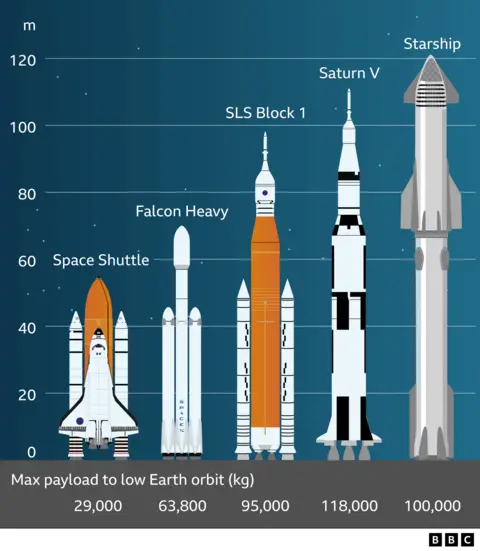
Starship is a two-stage vehicle. The “Ship” is the uppermost part, and that sits atop a booster called Super Heavy.
Thirty-three engines at the base of this booster produce around 74 meganewtons of thrust. To put that into perspective, it’s almost 700 times as powerful as the thrust generated by the common passenger plane, the Airbus A320neo.
If you’ve flown with Aer Lingus, British Airways or Lufthansa, imagine the kick of taking off in one of those planes. Then multiply that by 700.
The vehicle has grown about a metre since its second test flight in June of this year, with Starship now measuring just over 120m in total.
This additional height comes from the Super Heavy booster itself being made 1m longer.
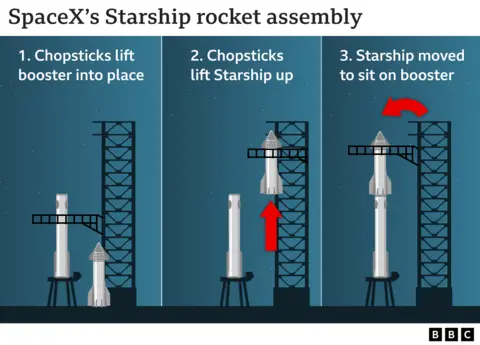
It’s also about twice as powerful as the Saturn V rocket which first took humanity to the Moon’s surface.
SpaceX says that power should be able to move a payload weighing at least 150 tonnes from the launchpad to low-Earth orbit.
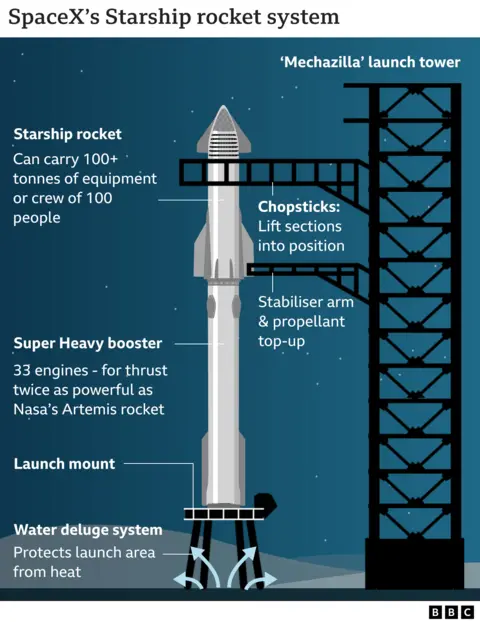
Both the Ship and the Super Heavy booster are fuelled with a mixture of icy-cold liquid methane and liquid oxygen fuel, known as methalox.
What has Starship done so far?
Starship has had four test flights up to now. During the first flight, the rocket system exploded early, before the Booster was able to separate.
It’s worth noting that such hiccups are part of SpaceX’s plan to speed up development by launching systems they know are not perfect and learning from the faults.
And each test has seen real progress – first with a hitch-free separation, and eventually a successful return, where both the Ship and the Booster made a controlled descent and hovered above the Indian Ocean and Gulf of Mexico respectively until splashing down.
 Getty Images
Getty ImagesHow does Starship land?
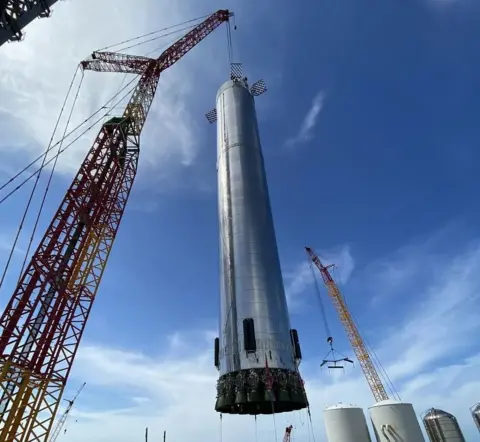 SpaceX
SpaceXAnyone watching nearby as the booster returns to Earth can expect a thunderous boom as it slows down from supersonic speeds.
While SpaceX plan to catch the booster with the launch tower, we won’t get a similar return of the top part – the Ship – this time. When we do, it shouldn’t look too different from the Super Heavy’s descent.
But since there’s no launch tower on Mars, or on the Moon for that matter, the Ship also needs to be able to land on its legs.
To do that, it manoeuvres itself horizontally as it starts to descend, in what Musk has called a ‘belly-flop’ manoeuvre. This increases the drag on the vehicle, slowing it down.
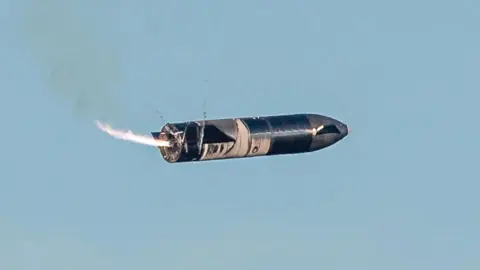 SpaceX
SpaceXOnce the Ship gets close enough to the surface, it’s then slow enough to fire its engines in a way that flips the vehicle into a vertical position.
The Ship then uses its rockets to guide itself down safely and land on a hard pad upon its landing legs.
All of this has been done by the Ship on its previous flight – apart from landing on a pad. So far it has only landed in the sea.
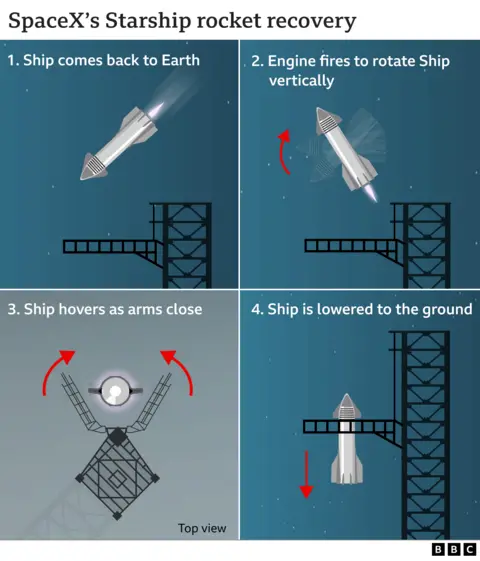
What are the challenges?
One of the purposes of test flying is to highlight problem areas, and the quick turnaround between each test flight means that weak links have to be redesigned at lightning speed.
If you get one thing wrong, the entire internal structure of the rocket could be melted by hot gases.
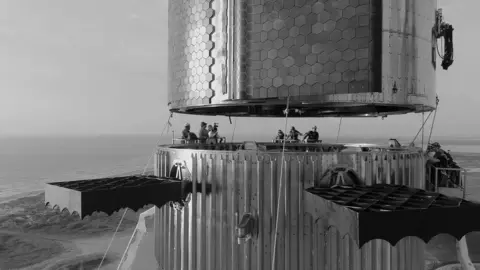 SpaceX
SpaceXWhat else will Starship be used for?
There are a few things Starship could be used for soon.
So far Musk has used his own rockets, like the Falcon 9 series, to launch his own commercial satellites, known as Starlink.
Those satellites have a short lifespan of around five years, and the flock in orbit needs to be constantly replenished just to keep the same number of satellites in space.
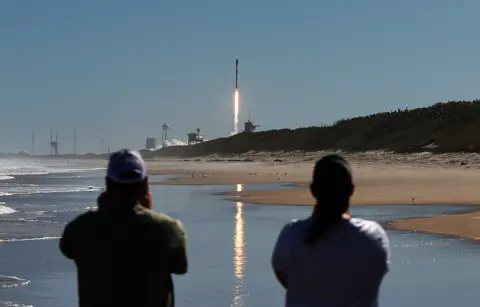 Getty Images
Getty ImagesNasa also wants to use Starship as part of its Artemis programme, which aims to establish a long-term human presence on the Moon.
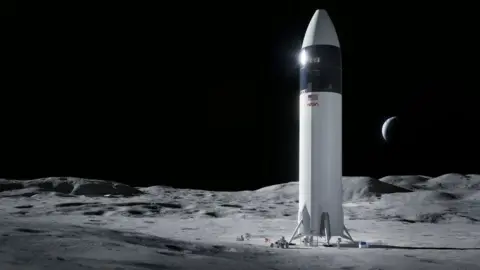 NASA
NASAIn the more distant future, Musk wants Starship to make long-haul trips to Mars and back – about a nine month trip each way.
“You could conceivably have five or six people per cabin, if you really wanted to crowd people in. But I think mostly we would expect to see two or three people per cabin, and so nominally about 100 people per flight to Mars,” Musk said.
The idea is to send the Ship part of the vehicle into low-Earth orbit, and “park” it there. It could then be refuelled in orbit by a SpaceX ‘tanker’ – essentially another Ship without the windows – for its onward journey to Mars.
It’s also conceivable that Starship could be used to launch space telescopes.
The Hubble telescope is about the size of a bus, and the James Webb telescope is almost three times as big as that.
To put up thousands of satellites quickly, or a bigger telescope, you need a big rocket.
Finally, Starship has also been built to carry heavy loads needed to build space stations, and eventually, infrastructure for a human presence on the Moon.
How much greenhouse gas does Starship emit?
A rocket that kicks 700 times harder than a passenger jet is bound to have some impact on the environment.
A draft environmental report by the US Federal Aviation Administration (FAA) released in July shows that the new licence SpaceX is applying for would allow them 25 launches of Starship per year.
The FAA say this would emit a total of 97,342 tonnes of CO2 equivalent – or 3,894 tonnes per launch.
In comparison, a typical car in the US emits about 4.6 tonnes of CO2 per year, according to the US Environmental Protection Agency.
If we crunch the numbers, that means one launch of Starship emits as much greenhouse gas as 846 cars would emit over the course of a year.
From a sheer numerical standpoint, that’s fairly insignificant compared to say, the commercial aviation industry.
But with Musk hoping to increase the number of launches to potentially hundreds per year in the future, those numbers could start adding up.
#Elon #Musks #Starship #space #vehicle










